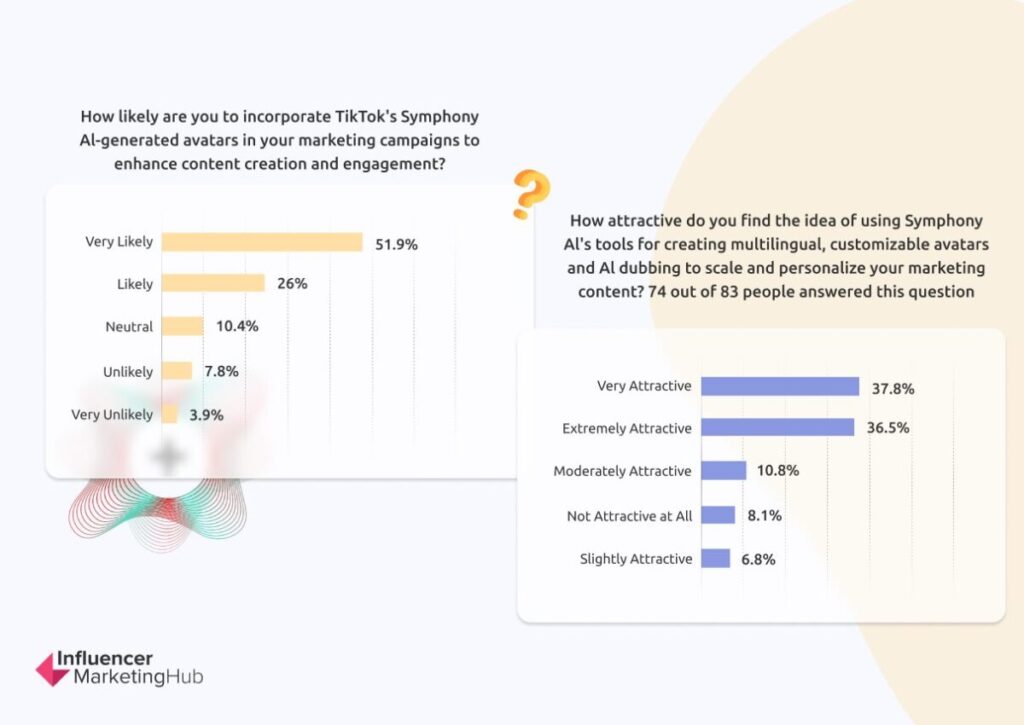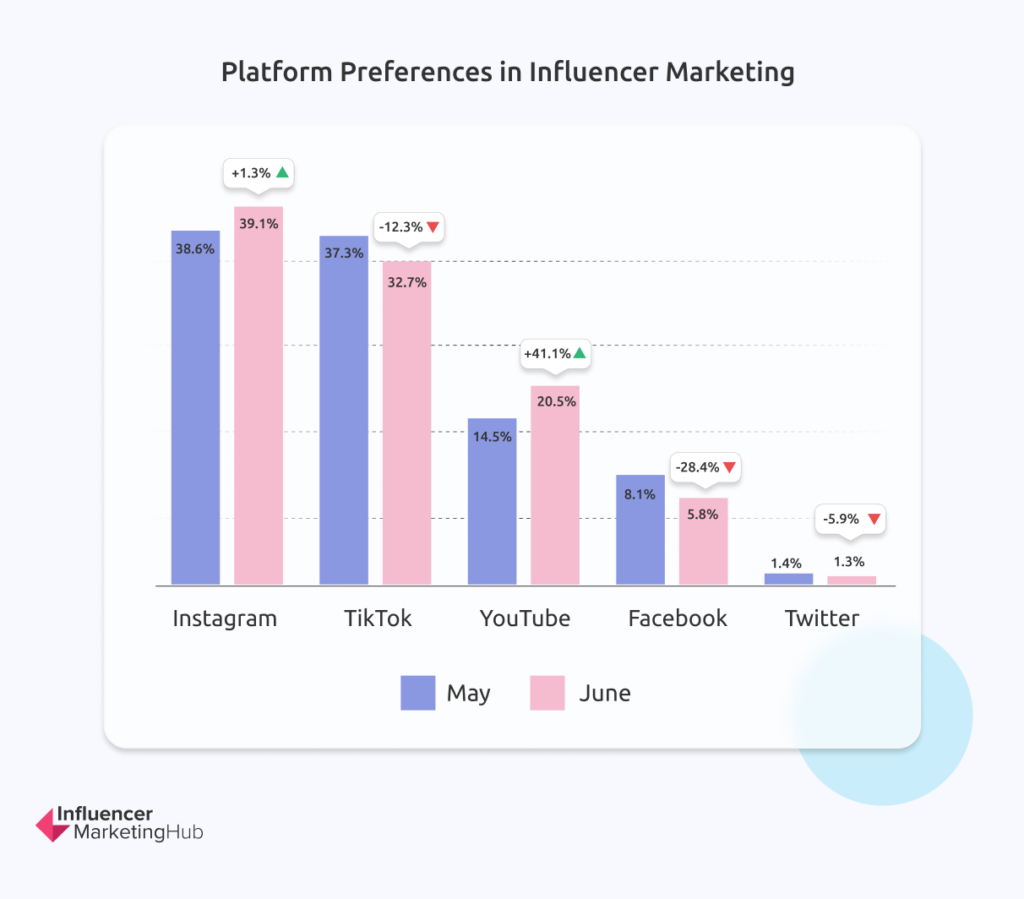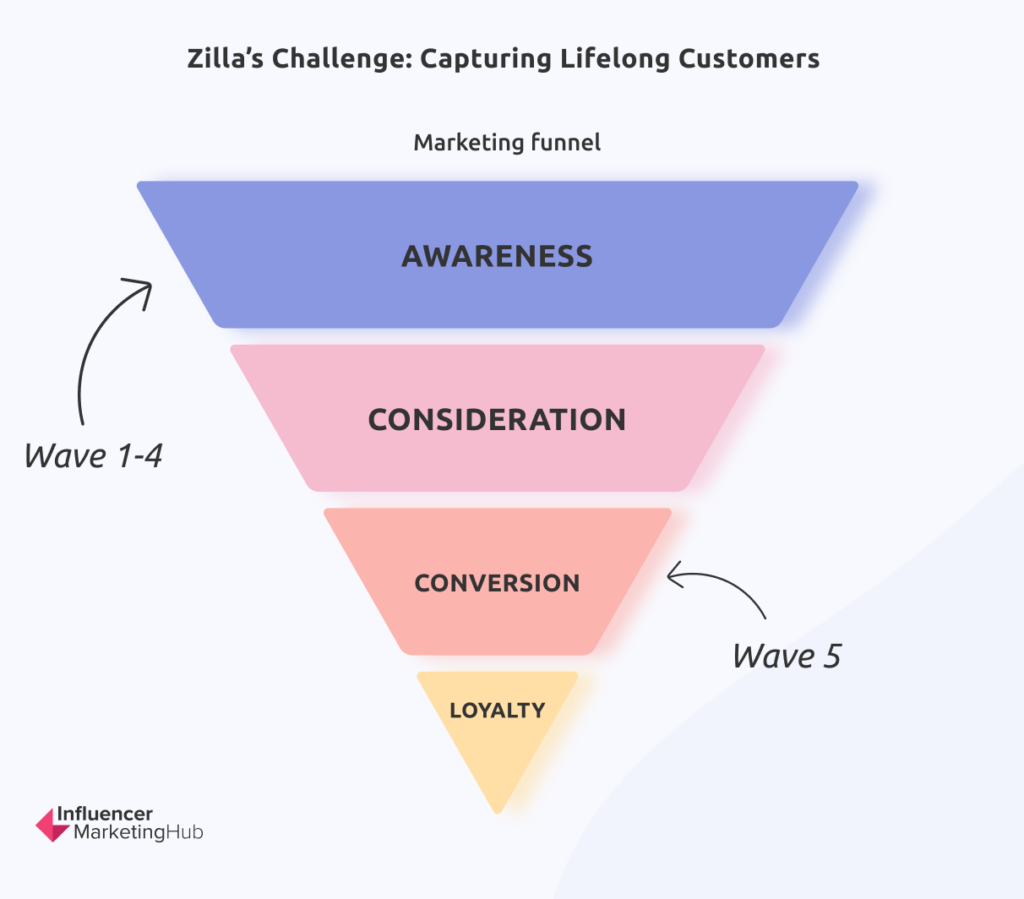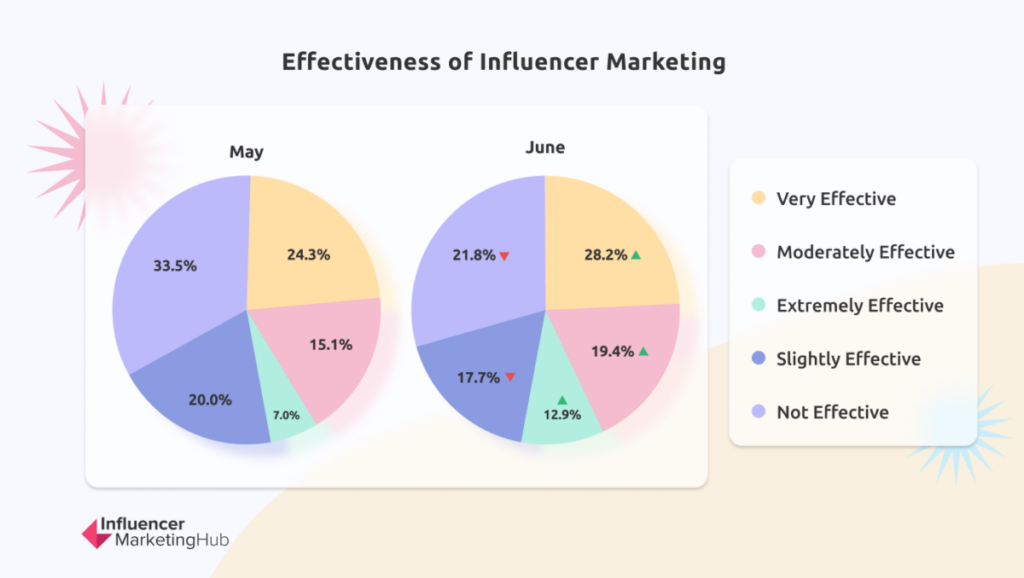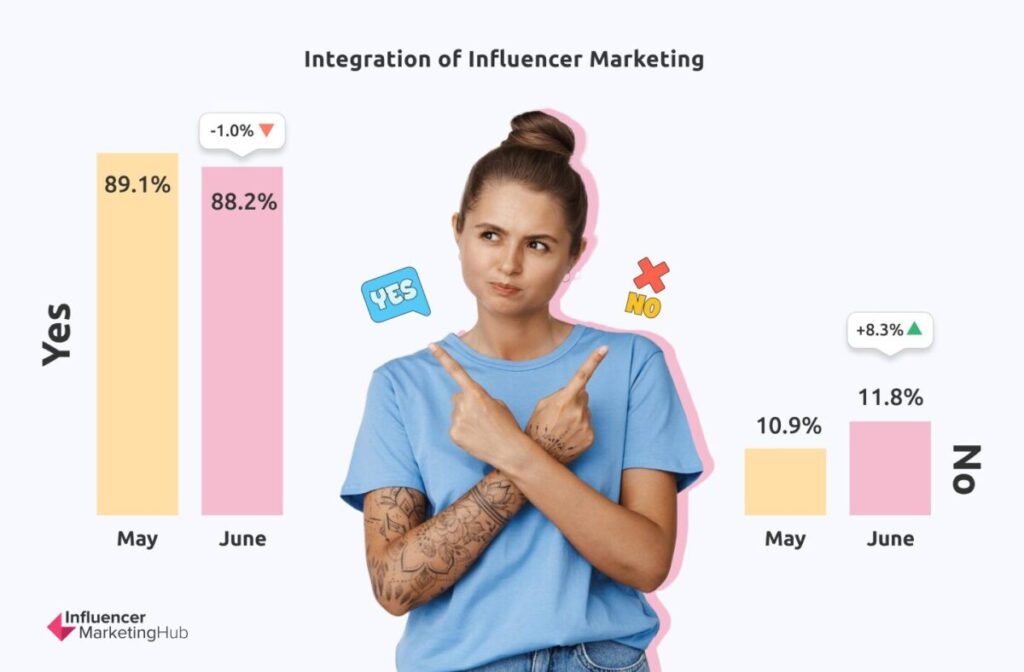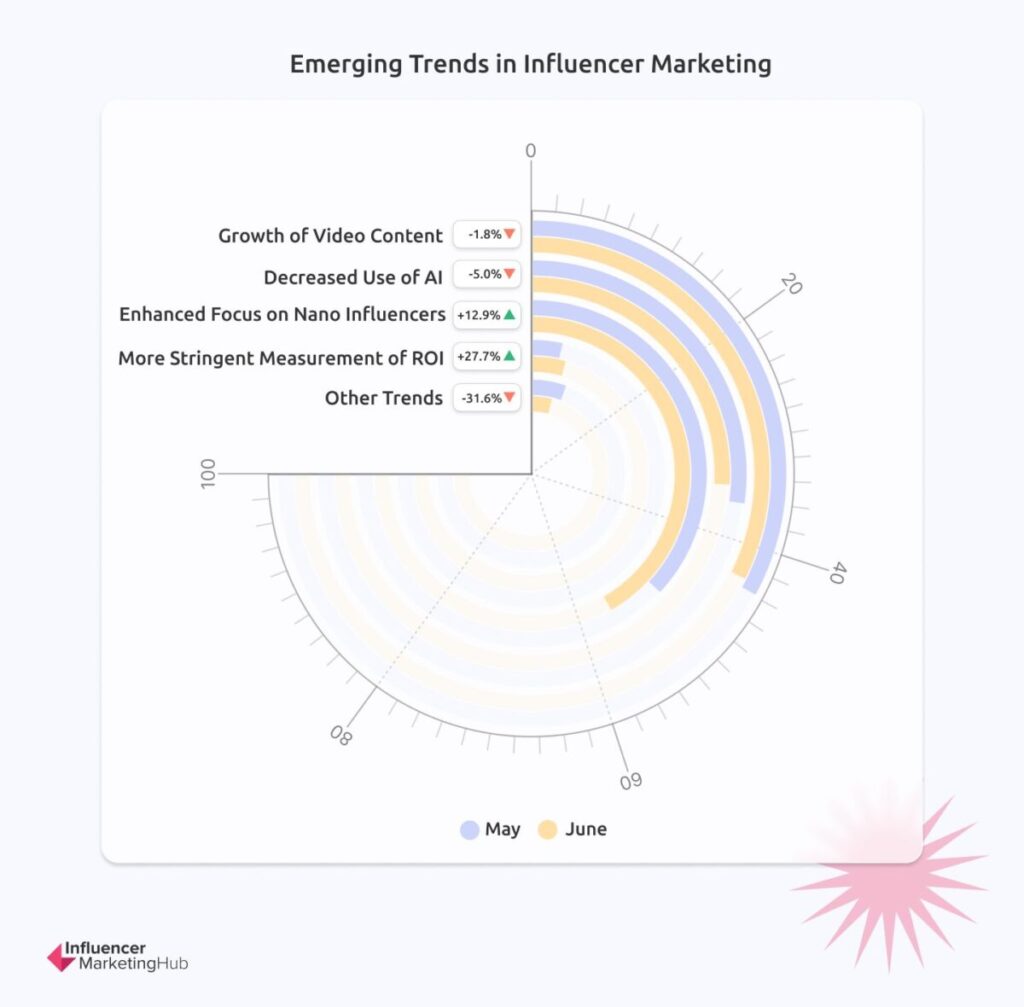Imagine this: Your mind wanders 47% of the time, and amidst the 11 million bits of sensory information we receive each second, we can only focus on forty. This attention gap is the battleground for modern marketing. As you dive into our latest report, we'll explore how the rise of nano influencers and groundbreaking AI technology, like TikTok's new Symphony feature, are designed to cut through the noise, capture attention, and build authentic connections in a world where focus is fleeting.
Influencer marketing is booming this June 2024, evolving faster than ever. Instagram’s dominance, TikTok’s surprising dip, and YouTube’s resurgence tell a story of shifting strategies and fresh opportunities. With insights from 399 marketing pros and a spotlight on Zilla’s incredible 9.2 million views TikTok campaign by Ubiquitous, this report breaks down the latest trends, challenges, and innovations shaping the future of influencer marketing. Dive in and discover how brands are leveraging influencer magic to connect with audiences in new and exciting ways. Before we dig into the monthly stats, our editorial team has handpicked notable trends that are shaping the current influencer marketing landscape.
IMH Editorial Team’s Handpicked Trends and Findings
45.8% expected rise in budgets allocated to influencer marketing
This month, our findings reveal a nuanced IM space where marketing professionals are increasingly confident in the power of influencer marketing. A significant 45.8% expected rise in budgets allocated to influencer marketing, with more than 30% of the total budget, underscores this growing confidence. Yet, the evolving platform preferences highlight a shift—TikTok usage has notably declined by 12.3%, while YouTube has surged with a 41.1% increase, suggesting marketers are recalibrating their strategies.
A recent article in The Information supports this observation. Major advertisers like Coca-Cola are shifting significant portions of their ad budgets to social media influencers. For example, Fanta's recent campaign opted entirely for TikTok over traditional TV, indicating confidence in influencer marketing's effectiveness. This shift underscores the critical need for marketers to understand and effectively use influencer strategies to remain competitive.
@kaanade Doing it the Fanta way is always the best way to go! #WantaFanta @Fanta ♬ Wanta Fanta? - Fanta
Influencer Marketing: Astounding 84.3% Surge in Effectiveness
Building on these positive trends, the perception of influencer marketing effectiveness is also improving. There's a substantial 84.3% increase in those finding it extremely effective MoM. However, 21.8% still find it not effective, highlighting ongoing skepticism and areas for improvement. This gap indicates a divergence in how well different marketers can leverage influencer marketing strategies. It suggests that while some have mastered the techniques to maximize ROI, others struggle with execution and measurement.
Emerging trends also reflect strategic shifts. There's an increase in the focus on nano-influencers, while a 27.7% rise in stringent ROI measurement indicates a move towards performance-driven campaigns. Videos continue to reign supreme, although we've noted a slight decline in its anticipated impact. These insights suggest that marketers are refining their approaches, prioritizing impactful engagements over sheer reach.
The AI Revolution in Influencer Marketing Led by TikTok
Influencer Marketing Hub has this year noticed innovative solutions rapidly emerging within the influencer marketing industry. For instance, IZEA’s launch of IZZY, a revolutionary AI assistant, promises to enhance and streamline influencer marketing efforts, demonstrating the industry’s rapid technological advancements. But that’s not all. TikTok has recently announced its groundbreaking Symphony feature on June 17, 2024, a suite of AI tools poised to redefine how ads are created on the platform.
According to a recent New York Times article, TikTok is testing tools that allow brands to create ads using avatars generated by artificial intelligence that look like real people. These avatars can be customized to resemble specific creators, placed in various settings, and even speak in multiple languages thanks to a new dubbing tool. This development aims to enhance and amplify human imagination rather than replace it, allowing creators to work faster and produce more content without sacrificing creativity.
Influencer Marketing Hub asked its readers, "How attractive do you find the idea of using TikTok Symphony AI’s tools for creating multilingual, customizable avatars and AI dubbing to scale and personalize your marketing content?" An overwhelming 74.3% found it highly attractive, reflecting strong interest and optimism in these AI advancements.
Additionally, when asked, "How likely are you to incorporate TikTok’s Symphony AI-generated avatars in your marketing campaigns to enhance content creation and engagement?" 77.9% of respondents indicated they are likely to do so, highlighting the significant potential of these tools in reshaping influencer marketing strategies.
According to TikTok, ads created with Symphony not only boost purchase intent by 37% but also enhance brand favorability by 38%, making it a game-changer for brands aiming to connect with their global audience authentically and effectively.
Everyday Consumers to Become Influencers
James Watt, founder of BrewDog, recently emphasized the changing economics of influencer marketing during the unveiling of his new venture, Social Tip. As reported by the Evening Standard, Watt’s platform aims to empower everyday consumers to become influencers, rewarding them based on engagement. This approach underscores the shift towards more authentic, grassroots-level influencer marketing, which aligns with our findings of an increased focus on nano-influencers.
The introduction of platforms like Social Tip marks a significant shift in influencer marketing towards ultra-nano influencers. By democratizing influence and empowering everyday consumers, brands can foster more authentic connections and drive engagement in a cost-effective manner. As the industry evolves, the role of ultra-micro influencers is likely to grow, offering brands new opportunities to connect with their audiences on a more personal and impactful level.
Influencers are grappling with reduced payments
Recent industry news supports these findings, revealing the complexities faced by influencers and brands alike. According to a recent Wall Street Journal article, influencers are grappling with reduced payments for their content and increased scrutiny from brands. Further complicating the influencer industry for creators are the Biden administration's efforts to ban TikTok in the US.
- In response to economic hardships, influencers are pivoting towards de-influencing, where they guide their audience on what not to buy and suggest more affordable alternatives. This trend is gaining popularity as consumers become more cost-conscious.
- De-influencing reflects a broader shift in consumer behavior towards more mindful spending, resonating with audiences who are feeling the pinch of economic pressures.
The Short Version – Quick Facts
- Rising YouTube Influence: YouTube saw a significant increase in usage from 14.5% to 20.5% (+41.1%), indicating a growing importance of long-form video content in influencer marketing strategies.
- Growing Budget Levels for IM: There was a notable increase in high-budget allocations with more than 30% of the marketing budget rising from 16.8% to 24.5% (+45.8%). Simultaneously, budgets of less than 10% decreased from 50.0% to 42.0% (-16.0%), suggesting increased confidence and investment in influencer marketing.
- Effectiveness Perception Boost: The perception of influencer marketing as extremely effective surged from 7.0% to 12.9% (+84.3%), while those finding it very effective also increased from 24.3% to 28.2% (+16.0%), reflecting a growing recognition of its efficacy.
- Emerging Trend on ROI Measurement: There's a 27.7% increase in stringent ROI measurement focus, rising from 4.7% to 6.0%, indicating a move towards greater accountability and precision in influencer campaigns.
- Focus on Nano Influencers: Engagement with micro influencers (10K–100K followers) decreased from 25.74% to 20.32% (-21.1%), while nano influencers (1K–10K followers) increased from 49.26% to 55.61% (+12.9%), reflecting a strategic pivot towards achieving authenticity through niche engagements.
While influencer marketing shows enduring resilience and adaptability, marketers must stay vigilant, agile, and creative to thrive amidst new uncertainties and shifting trends. Stay ahead, stay informed, and leverage these insights to craft strategies that resonate and convert. Now, let’s dive deeper into our MoM analysis and explore one of the most intriguing case studies we’ve examined in the influencer marketing game.
MoM Trends in Influencer Marketing
First party data by Influencer Marketing Hub monthly Survey
As we compare the findings of our June 2024 survey with those from our May report, several significant trends and shifts emerge. These insights offer a deeper understanding of how influencer marketing is evolving month over month. Notably, we observed a dramatic decrease in TikTok's usage coupled with a surge in YouTube's popularity, indicating a shift in platform preference. Additionally, budget allocations and perceptions of influencer marketing's effectiveness have seen noteworthy changes. This dynamic environment underscores the importance of staying attuned to the latest developments and adjusting strategies accordingly. Our detailed MoM analysis provides a comprehensive look at these transformations.
Platform Preferences in Influencer Marketing
The landscape of influencer marketing platforms remains highly competitive and dynamic. According to our survey:
- Instagram: Slight increase from 38.6% in May to 39.1% in June (+1.3%). Instagram remains a dominant platform, maintaining its top preference among marketers.
- TikTok: Noticeable decrease from 37.3% to 32.7% (-12.3%). This significant drop might suggest a shift in marketers' strategies or audience engagement patterns amidst evolving regulatory concerns.
- YouTube: Increase from 14.5% to 20.5% (+41.1%). YouTube's rising preference indicates a growing importance of long-form video content.
- Facebook: Drop from 8.1% to 5.8% (-28.4%). The decline in Facebook's use might reflect shifting demographics or platform engagement challenges.
- Twitter: Slight decrease from 1.4% to 1.3% (-5.9%). Twitter continues to play a minimal role in influencer marketing strategies.
These shifts mirror industry realities, like those highlighted in a recent Wall Street Journal article, where influencers face reduced payments and increased brand scrutiny.
Types of Influencers Primarily Engaged With
Marketers show a clear preference for more accessible influencers, indicating a shift towards authenticity:
- Nano Influencers (1K–10K followers): Increase from 49.26% to 55.61% (+12.9%). Marketers might be gravitating towards influencers with larger followings.
- Micro Influencers (10K–100K followers): Decrease from 25.74% to 20.32% (-21.1%). The decline highlights a shift in engagement strategies.
- Macro Influencers (100K–1M followers): Increase from 12.50% to 14.97% (+19.8%). There might be a growing belief in the potential of macro influencers.
- Mega or Celebrity Influencers (1M+ followers): Decrease from 12.50% to 9.09% (-27.3%). High-profile influencers are losing traction in favor of other tiers.
The Power of Precision: How Zilla Achieved 9.2 Million Views and 58K Paid Clicks
Ubiquitous’ collaboration with Zilla exemplifies the transformative power of effective influencer marketing. Through strategic planning, precise execution, and innovative content creation, Zilla has achieved significant growth and established itself as a lifelong brand for reptile owners. This case study serves as a testament to the impact of well-orchestrated influencer campaigns, providing valuable insights for future marketing endeavors.
Influencer marketing demands a blend of strategic planning, creative storytelling, and human engagement. Unlike performance marketing, which relies on algorithms, influencer marketing leverages human connection, requiring precise alignment and motivation.
Zilla’s Challenge: Capturing Lifelong Customers
Reptiles are unique pets that often result in lifelong brand loyalty once owners choose a preferred supplier. Zilla, with its high-quality reptile products, needed to capitalize on this by securing new, loyal customers through a targeted influencer campaign. Knowing that younger demographics use TikTok extensively, Zilla aimed to dominate this platform to reach Gen Z and Millennial reptile owners.
Transition from Instagram to TikTok
Zilla had experience with Instagram but needed expertise to navigate TikTok’s influencer landscape. Ubiquitous provided the necessary support, helping Zilla transition smoothly. The goal was clear: turn TikTok into a significant revenue driver and establish Zilla as the go-to brand for reptile enthusiasts.
Campaign Goals and Objectives
- Brand Awareness: Achieve at least one million views per campaign wave.
- Cost Efficiency: Maintain a CPM below $13.
- Revenue Growth: Increase online sales on Zilla’s website.
- Engaging Content: Collaborate with responsible reptile owners to create educational and entertaining content.
Strategy and Execution
Finding the Right Influencers
Ubiquitous faced the challenge of finding reptile influencers who met ethical standards and had not engaged in brand collaborations before. After thorough research, they identified 18 suitable influencers, emphasizing long-term partnerships over one-off engagements.
Structured Campaign Waves
Ubiquitous designed a seven-wave campaign, each focusing on different aspects of brand engagement and sales:
1. Waves 1-3: Brand Awareness
- Content: Educational and pet-focused videos.
- Results: 4.5 million views, 2.97% engagement rate, $9.20 CPM.
2. Wave 4: Brand Awareness with a Twist
- Content: Collaborations with makeup creators, integrating reptiles into creative themes.
- Results: 1.1 million views, 1.59% engagement rate, $12.14 CPM.
3. Wave 5: Traffic Generation
- Content: Product-focused and organically integrated videos.
- Results: 1.1 million views, 4.67% engagement rate, $12.79 CPM.
4. Wave 6: Brand Awareness
- Content: Highlighting reptile companionship.
- Results: 1.3 million views, 1.41% engagement rate, $10.39 CPM.
5. Wave 7: Traffic Campaign with Spark Ads
- Content: A mix of product-focused and creatively free videos.
- Results: 952,709 views, 5.9% CTR, $15 CPM, 38,000 paid clicks.
Results and Insights
- Total Views: Over 9.1 million views.
- Engagements: Nearly 253,000.
- CPM: $11.
- Paid Clicks: 58,826.
Key Insights
1. Niche Adaptation: Collaborating with makeup creators expanded Zilla’s reach beyond traditional reptile content.
2. Multi-Wave Success: Long-term campaigns allow for strategic audience engagement and conversion.
3. Balanced Content Strategy: Combining product-focused and creative freedom content maximized engagement and click-through rates.
Zilla’s Testimonial:
“Working with Ubiquitous has been a game-changer for us. Their seamless process and expert guidance have made working with influencers effortless. The content produced is not only exceptional but also perfectly aligned with our brand goals. Thanks to Ubiquitous, we've seen significant expansion in our digital footprint and reached new heights in audience engagement. They're not just an agency; they're a key partner in our success story!”
— Mayra Damien, Associate Brand Manager at Zilla
A significant rise in high-budget allocations for IM
Despite varying opinions on effectiveness, the commitment to influencer marketing remains strong:
- Less than 10%: Decrease from 50.0% in May to 42.0% in June (-16.0%). There's a reduced tendency to allocate minimal budgets, hinting at increased investment confidence.
- 10-20%: Slight increase from 22.1% to 23.1% (+4.5%). Consistency in moderate budget allocation suggests stable confidence in influencer marketing's returns.
- 21-30%: Slight decrease from 11.1% to 10.5% (-5.4%). This segment shows a stable investment approach.
- More than 30%: Increase from 16.8% to 24.5% (+45.8%). A significant rise in high-budget allocations indicates a strong belief in the effectiveness of influencer strategies.
Effectiveness of Influencer Marketing in Achieving Marketing Goals
Our survey indicates a shifting perception of influencer marketing effectiveness:
- Very Effective: Increase from 24.3% to 28.2% (+16.0%). There is a growing recognition of influencer marketing's efficacy.
- Moderately Effective: Increase from 15.1% to 19.4% (+28.5%). More marketers find influencer marketing to be a reliable strategy.
- Extremely Effective: Increase from 7.0% to 12.9% (+84.3%). The sharp rise underscores a significant positive shift in perceived effectiveness.
- Slightly Effective: Decrease from 20.0% to 17.7% (-11.5%). Reflects a slight drop in skepticism.
- Not Effective: Decrease from 33.5% to 21.8% (-35.0%). A substantial reduction in negative perceptions indicates improved confidence.
Integration of Influencer Marketing with Other Marketing Efforts
Integration remains high.
- Yes: Slight decrease from 89.1% in May to 88.2% in June (-1.0%). High integration levels signify that influencer marketing complements broader strategies.
- No: Increase from 10.9% to 11.8% (+8.3%).
Emerging Trends Anticipated to Impact Influencer Marketing
Our findings reveal emerging trends and future focus areas:
- Video Content Still Most Popular: Slight decrease from 43.9% to 43.1% (-1.8%). Video content remains crucial, though its anticipated impact slightly waned.
- Use of AI: Decrease from 36.3% to 34.5% (-5.0%). AI's projected impact is still strong but shows a minor decline.
- Enhanced Focus on Nano Influencers: Nano influencers (1K–10K followers) increased from 49.26% to 55.61% (+12.9%). There’s a growing focus on leveraging smaller influencers for niche engagement.
- More Stringent Measurement of ROI: Increase from 4.7% to 6.0% (+27.7%). Accountability and precise ROI measurement in influencer campaigns are gaining importance.
- Other Trends: Decrease from 7.6% to 5.2% (-31.6%). Fewer marketers are focused on unspecified other trends, possibly indicating a consolidation around key trends.
Focus on Direct Sales vs. Brand Awareness
Campaign objectives reveal a strategic shift:
- Mostly Direct Sales: Decrease from 53.6% to 48.8% (-9.0%). There's a slight shift from direct sales focus towards multi-goal strategies.
- Mostly Brand Awareness: Increase from 28.3% to 29.9% (+5.7%). Slightly more emphasis on brand awareness campaigns.
- Balanced Approach: Increase from 18.1% to 21.3% (+17.7%). A balanced strategy focusing on both sales and brand awareness is gaining favor.
Key Takeaways
These trends reflect the resilience and adaptability of influencer marketing. Marketers are not only increasing their investments but also refining their strategies to leverage emerging trends and technologies. The integration of AI, as seen with IZEA's IZZY, underscores the potential for enhanced precision and accountability in influencer campaigns. Moreover, the shift towards nano-influencers, as emphasized by James Watt’s Social Tip, highlights a drive for authentic and grassroots-level engagements.
Navigating these insights, marketers must stay vigilant and agile to thrive amidst the shifting landscape of influencer marketing.
Stay ahead, stay informed, and leverage these insights to craft strategies that resonate and convert.
The marked increase in YouTube usage from 14.5% to 20.5% (+41.1%) alongside a significant drop in TikTok usage from 37.3% to 32.7% (-12.3%) highlights an evolving platform preference. This shift suggests that marketers need to remain agile, diversify their platform strategies, and be prepared to pivot in response to changing audience behaviors and regulatory challenges.
With a 45.8% rise in influencer marketing budgets, and more than 30% of total budgets now being allocated, there's evident confidence in the long-term effectiveness of influencer marketing. This substantial investment underscores the importance of influencers in current and future campaigns, particularly emphasizing video content.
The perception of influencer marketing as extremely effective has surged by 84.3%, with those finding it very effective also increasing by 16.0%. This positive shift suggests marketers are witnessing greater ROI from influencer activities, signaling the need to continue refining and investing in influencer partnerships.
The rise in focus on stringent ROI measurement from 4.7% to 6.0% (+27.7%) indicates that marketers are increasingly prioritizing accountability and precise performance metrics. This trend points to a need for advanced analytics to track and enhance the effectiveness of influencer marketing campaigns.
The decreased engagement with micro influencers (10K-100K followers) from 25.74% to 20.32% (-21.1%) and the increased focus on nano influencers from 49.26% to 55.61% (+12.9%) reflect a strategic pivot towards authenticity. This movement underscores the increasing value of niche influencers who can foster deeper connections with their audiences and enhance brand trust.
Looking Ahead
As the influencer marketing landscape continues to evolve, the focus on personalized and authentic engagements through nano influencers will likely intensify. The rising significance of video content and the ongoing refinement of measurement techniques point to a future where strategy and precise analytics are key. Marketers must stay ahead of these trends, integrating advanced tools like AI to enhance their strategies and drive meaningful outcomes.
Action Tips for Thriving in 2024
To navigate this dynamic landscape and capitalize on emerging trends, marketers are advised to:
1. Diversify Platform Strategies: Adapt to shifting platform preferences, leveraging the growing importance of YouTube and preparing for potential regulatory impacts on platforms like TikTok. Stay agile and ready to pivot your strategies to where your audience is most active and engaged.
2. Invest in Authentic Influencer Partnerships: Focus on building relationships with nano influencers to foster genuine engagement and trust with your audience. Emphasize authenticity and relatability, as these influencers often provide more impactful and trustworthy endorsements.
3. Enhance Analytic Capabilities: Prioritize precise ROI measurement and leverage advanced analytics to track and optimize the performance of your influencer marketing campaigns. Utilize tools that offer deep insights into campaign effectiveness to make data-driven decisions and improve results.
4. Embrace Technological Innovations: Utilize AI-driven tools, such as Upfluence, Brandwatch, and Symphony, TikTok’s latest AI innovation announced in June 2024, to streamline influencer identification, content creation, and campaign management for improved efficiency and effectiveness. These innovations can significantly enhance the scale and creativity of your campaigns while reducing operational burdens.
By embracing these strategies, marketers can ensure their influencer marketing efforts not only resonate deeply with their target audiences but also achieve measurable and impactful business results.
Methodology and Data Transparency
To ensure the highest degree of reliability and transparency, this Influencer Marketing Benchmark Report is based on a meticulously conducted survey involving 399 marketing professionals. These participants were sourced across diverse sectors, ensuring a broad representation of the industry.
Survey Execution:
The survey was hosted and administered via influencermarketinghub.com, targeted specifically at pages related to influencer marketing topics to reach the most relevant audience. This method ensured that the respondents were professionals actively engaged with or interested in influencer marketing strategies, providing insights that are both relevant and actionable.
Data Collection and Accessibility:
We utilized a comprehensive online survey platform that allowed for detailed question structuring and response analysis. The survey included a variety of question types, such as multiple choice, scale rating, and open-ended responses, to gather nuanced data on influencer marketing practices, challenges, and trends.
Transparency and Access to Data:
In commitment to transparency and to foster trust with our readers, the complete dataset from the survey is available for review. This dataset includes all responses, anonymized to protect the privacy of the participants, along with the methodologies used for data collection and analysis. Access to this dataset allows interested parties to perform their own analysis and verify the findings presented in this report.
Proof of Methodology:
We ensure that all survey practices adhere to high standards of research integrity and ethical guidelines. The survey was designed to avoid leading questions, minimize bias, and provide respondents with the freedom to express their true opinions and experiences in influencer marketing.
Continued Engagement and Updates:
This report is part of an ongoing series that tracks trends and changes in influencer marketing annually. We continuously refine our methodology based on feedback and evolving research standards to enhance the accuracy and relevance of the information we provide.
By sharing our methodology and data, we aim to contribute to the growing body of knowledge in influencer marketing and support marketers in making informed decisions that drive success in their campaigns.

